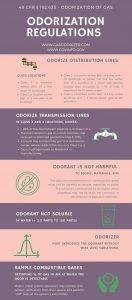What are the natural gas odorization requirements?
Understanding the natural gas odorization requirements is crucial for industry professionals. The regulations are published below, but what do they all mean? Let’s delve into them to ensure we’re all on the same page.
Natural Gas Odorization Requirements
In its raw form, natural gas is not only odorless but also highly combustible, posing significant safety risks. The process of odorization, which involves adding an odorant to the gas, is a vital safety measure. It serves as a warning signal, alerting a bystander to the presence of natural gas and potentially averting a catastrophic event.
As per the Federal Pipeline Safety Regulations (49 CFR 192.625), all combustible gas transported via pipeline must meet a minimum odorization standard. This standard stipulates that distribution lines and some transmission lines ( as outlined in the regulations) must contain odorant at a concentration of 20% of the lower explosive limit. This ensures that a person with a ‘typical’ sense of smell can detect it, thereby enhancing safety. For more comprehensive details, please refer to “What is natural gas odorization?”

Want More Info on GPL Odorizers? Ask Here!
Odorization Regulations
PART 192: TRANSPORTATION OF NATURAL AND OTHER GAS BY PIPELINE: MINIMUM FEDERAL SAFETY STANDARDS
Subpart L: Operations
192.625 – Odorization of gas.
(a) A combustible gas in a distribution line must contain a natural odorant or be odorized so that at a concentration in air of one-fifth of the lower explosive limit, the gas is readily detectable by a person with a normal sense of smell.
(b) After December 31, 1976, a combustible gas in a transmission line in Class 3 or Class 4 location must comply with the requirements of paragraph (a) of this section unless:
(1) At least 50 percent of the length of the line downstream from that location is in Class 1 or Class 2 location;
(2) The line transports gas to any of the following facilities which received gas without an odorant from that line before May 5, 1975;
(i) An underground storage field;
(ii) A gas processing plant;
(iii) A gas dehydration plant; or
(iv) An industrial plant using gas in a process where the presence of an odorant:
(A) Makes the end product unfit for the purpose for which it is intended;
(B) Reduces the activity of a catalyst; or
(C) Reduces the percentage completion of a chemical reaction;
(3) In the case of a lateral line that transports gas to a distribution center, at least 50 percent of the length of that line is in Class 1 or Class 2 location; or
(4) The combustible gas is hydrogen intended for use as a feedstock in a manufacturing process.
(c) In the concentrations in which it is used, the odorant in combustible gases must comply with the following:
(1) The odorant may not be deleterious to persons, materials, or pipe.
(2) The products of combustion from the odorant may not be toxic when breathed, nor may they be corrosive or harmful to those materials to which the products of combustion will be exposed.
(d) The odorant may not be soluble in water to an extent greater than 2.5 parts to 100 parts by weight.
(e) Equipment for odorization must introduce the odorant without wide variations in the level of odorant.
(f) To assure the proper concentration of odorant in accordance with this section, each operator must conduct periodic sampling of combustible gases using an instrument capable of determining the percentage of gas in air at which the odor becomes readily detectable. Operators of master meter systems may comply with this requirement by?
(1) Receiving written verification from their gas source that the gas has the proper concentration of odorant; and
(2) Conducting periodic “sniff” tests at the extremities of the system to confirm that the gas contains odorant.
[35 FR 13257, Aug. 19, 1970]Who are we?
We are the master distributor for GPL Odorizers, the manufacturer of SMART, eco-friendly, and accurate gas odorizers. We are confident that our products can meet your needs and enhance your safety measures. Let us know if we can help you!
You may also be interested in:
What is odor fade? What causes odor loss in odorized natural gas?
Smelling natural gas is a warning that there is a gas leak, but it’s not foolproof. What is odor fade? What causes the loss of odorized natural gas? Learn about odor fade.




Can an odorant harm you? Our gas company added too much odorants to the gas line and now all the houses in our neighborhood reaks of gas. We have had the gas company come out twice and they finally told us that too much odor was put in the lines and it will take a few days to disapate. Will too much or dormant harm my family. We have 3 small children/babies. You can smell it as soon as you walk in the house.
What are the short and long term health risks of exposure to mercaptan? If the person was not provided any safety tools or protective clothing? After exposure on numerous occasions, person reeked of smell which was in the skin, breathe, etc.
How often do we check the odorant level?